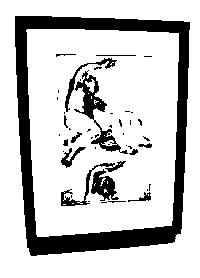
Art History professor Susan Wegner, James Miller '14, Ursula Moreno-VanderLaan '13 and Sarah Haimes '15 with their exhibition, "Michelangelo: Art and Afterlife"
At the end of the fall semester, the Bowdoin College Museum of Art hosted a short-lived but intriguing show on the deep and lasting impact of Michelangelo.
Museumgoers who managed to catch Michelangelo: The Art and Afterlife during the two weeks it was up in December were able to see a number of unusual pieces pulled from the museum archives. The show was curated by three art history students, and highlighted the way Michelangelo has influenced, both in subtle and obvious ways, the work of other artists during and after his lifetime.
Sarah Haimes ’15, James Miller ’14 and Ursula Moreno-VanderLaan ’13 put together the Michelangelo show as part of a class, The Art and Life of Michelangelo, taught by Associate Professor of Art History Susan Wegner. While none of the show’s pieces is by Michelangelo, “together [the 10 pieces chosen and interpreted by the students] tell part of the story of Michelangelo’s spiritual life and enduring fame,” the catalog says.
The most contemporary piece in the small show was a 1965 portrait of Michelangelo by Tom Cornell, Bowdoin’s former Richard E. Steele Artist-in-Residence Emeritus. “It shows the lasting influence of Michelangelo,” Wegner said. Cornell recently passed away, and the students and Wegner wanted to honor his memory and his art.
Cornell did the print when he was 27, likely based on painted portraits of a mature Michelangelo by Venusti and others. Cornell’s portrait, however, shows a younger Michelangelo, closer to his own age. “I think there was always some sort of kindred spirit thing going on between Tom and Michelangelo,” Wegner said. “It seems to me that Tom’s portrait of Michelangelo rounds out the face a bit, maybe with a tinge of self-portraiture in it?”
The three students collaborated on every part of the show, from choosing artworks to researching and writing wall labels. The students also each selected one aspect of Michelangelo’s art and influence to study in depth.
One issue in particular stirred Miller. Pointing to Sketches of Grotesque Ornaments, by unknown Flemish artists, Miller, who researched the grotesque, said, “The grotesque had a special status in the Renaissance.”
Sketches of Grotesque Ornaments depicts a series of masks, possibly drawn by a master artist and his pupils over time as they collected and invented grotesque masks for a studio sketchbook. “Now it’s seen as eerie and scary, but most people viewed it then as a testament to the artist’s imagination and sense of humor,” Miller said. Grotesque masks frequently appear in Michelangelo’s work.
Moreno-VanderLaan zeroed in on the 17th-century chalk drawing, Studies for an Allegory of Love, by Niccolò Berrettoni, to illustrate reactions to Michelangelo’s representation of women. She described Michelangelo’s depictions of human musculature, both female and male, as “dynamic, twisted forms, with strained muscles popping out.” But Berrettoni, and other artists, attempted to improve on Michelangelo’s treatment of women by softening their lines to create a more believable female body, Moreno-VanderLaan said.
Haimes, who researched Michelangelo’s approach to anatomy, spoke about Domenico Cunego’s copy of the Sistine Chapel scene where God gives life to Adam. There are a number of changes the artist made to Michelangelo’s original, including his addition of fig leaves to the genitalia of Adam and several child angels. Cunego also obscured the more evil angels, downplaying their frightful presence. Overall, the piece’s modest quality emphasizes Michelangelo’s mastery. “In [Cunego’s] print, Adam, his face indifferent, lounges in relaxation, completely lacking the vibrant energy of the muscular body and outstretched arm of the original,” the students’ wall text points out.
The students said they spent a long time discussing and analyzing Giorgio Ghisi’s print, Allegory of Life, which may represent both Michelangelo’s genius and his suffering. One side of the print is a dark wood of half human/half animal beings, monsters and other beasts. Here an old Michelangelo stands, reaching across a river to a lush and verdant landscape. “It’s a representation of Michelangelo’s mind,” Haimes suggested.
The students wrote in the accompanying wall text: “Through stark contrasts, Ghisi effectively depicts the creative genius at a crossroads. His deep melancholy could condemn him to “˜sit and sit forever’ in gloom as the text below him reads. Or, he could strive to cross the black water and gain the paradise on the bright shore.”
һ
“¬









